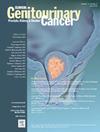一项试点单中心前瞻性研究的可行性和诊断性能:psma靶向活检与融合指导在mri阴性男性中检测具有临床意义的前列腺癌
IF 2.7
3区 医学
Q3 ONCOLOGY
引用次数: 0
摘要
当代前列腺活检采用多参数磁共振(MRI)引导;然而,它可能无法识别不可忽略的比例的男性临床显著(csPCa)。本研究的主要目的是评估前列腺特异性膜抗原靶活检(PSMA-TB)在MRI阴性且临床PCa风险高的男性中诊断csPCa的可行性和诊断性能。患者和方法:开放标签、单中心、非随机、前瞻性研究。纳入标准:PSA密度(PSAd)≥0.2 ng/ml2,男性PIRADS 1-2;PSA >;10 ng/ml或直肠指检异常或有强烈的PCa病史或已知的基因突变。每位患者均行PSMA-PET和经会阴融合PSMA-TB±系统活检(SB)。结果共纳入35例患者;23例(65.7%)男性PSMA-PET阳性(PRIMARY评分≥3)。总体而言,14名(40%)男性患有csPCA, 21名(60%)患者在PSMA-TB+SB有任何PCa。只有1例PSMA-PET阴性患者(8.3%)在SB(92%阴性预测值[NPV])有csPCa (ISUP 3)。23例PSMA-PET阳性患者中有12例(52.2%)单独融合PSMA-TB检测到csPCa;合并合并SB的PSMA-TB将csPCa的检出率提高到56.5%(增加值4.3%)。PSMA-TB+SB检测csPCa的敏感性、特异性、阳性预测值(Positive Predictive Value, PPV)、NPV和AUC分别为93%、57%、59%、92%和0.75,检测任何PCa的敏感性、特异性、阳性预测值(Positive Predictive Value, PPV)、NPV和AUC分别为91%、79%、86%、95%和0.84。本研究的主要局限性是样本量小。结论PSMA-TB融合技术可行,可提高MRI阴性患者csPCa的检出率。本文章由计算机程序翻译,如有差异,请以英文原文为准。
PSMA-Targeted Biopsy With Fusion Guidance for Detecting Clinically Significant Prostate Cancer in Men With Negative MRI-Feasibility and Diagnostic Performance of a Pilot Single-Center Prospective Study
Introduction
Contemporary prostate biopsy utilizes multiparametric magnetic resonance (MRI) guidance; however, it may fail to identify a non-negligible proportion of men with clinically significant (csPCa). The main objective of this study was to assess the feasibility and diagnostic performance of Prostate Specific Membrane Antigen-Target biopsy (PSMA-TB) to diagnose csPCa in men with negative MRI and high clinical risk of PCa.
Patients and Methods
Open-label, single-center, nonrandomized, prospective study. Inclusion criteria: PSA density (PSAd) ≥0.2 ng/ml2 in men with PIRADS 1-2; PSA >10 ng/ml or abnormal digital rectal examination or strong familiar history for PCa or known genetic mutation. Each patients underwent PSMA-PET and transperineal fusion PSMA-TB ± systematic biopsy (SB).
Results
Overall, 35 patients were enrolled; 23 (65.7%) men had positive PSMA-PET (PRIMARY score ≥3). Overall, 14 (40%) men had csPCA and 21 (60%) patients had any PCa at PSMA-TB+SB. Only 1 patient (8.3%) with negative PSMA-PET had csPCa (ISUP 3) at SB (92% Negative Predictive Value [NPV]). Fusion PSMA-TB alone detected csPCa in 12 out of 23 (52.2%) patients with positive PSMA-PET; fusion PSMA-TB with concomitant SB increased the detection of csPCa to 56.5% (added value of 4.3%). The sensitivity, specificity, Positive Predictive Value (PPV), NPV and AUC of PSMA-TB+SB were 93%, 57%, 59%, 92% and 0.75 for detection of csPCa and 91%, 79%, 86%, 95% and 0.84 for detection of any PCa, respectively. The main limitation of this study is its small sample size.
Conclusions
Fusion PSMA-TB is technically feasible and may improve the detection of csPCa in patients with negative MRI.
求助全文
通过发布文献求助,成功后即可免费获取论文全文。
去求助
来源期刊

Clinical genitourinary cancer
医学-泌尿学与肾脏学
CiteScore
5.20
自引率
6.20%
发文量
201
审稿时长
54 days
期刊介绍:
Clinical Genitourinary Cancer is a peer-reviewed journal that publishes original articles describing various aspects of clinical and translational research in genitourinary cancers. Clinical Genitourinary Cancer is devoted to articles on detection, diagnosis, prevention, and treatment of genitourinary cancers. The main emphasis is on recent scientific developments in all areas related to genitourinary malignancies. Specific areas of interest include clinical research and mechanistic approaches; drug sensitivity and resistance; gene and antisense therapy; pathology, markers, and prognostic indicators; chemoprevention strategies; multimodality therapy; and integration of various approaches.
 求助内容:
求助内容: 应助结果提醒方式:
应助结果提醒方式:


